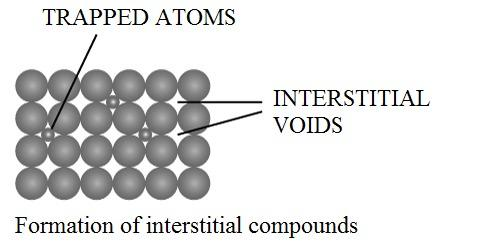
What are interstitial compounds? Why do these compounds have higher melting points than corresponding pure metals?
Answer
213.9k+ views
Hint: The melting point of an element or a compound can be stated as the temperature or the point when a solid changes its state to liquid.
Complete step-by-step solution:
Interstitial compounds are marked by the presence of some atoms like ${\rm{N,C}}$or ${\rm{H}}$. These atoms are trapped inside of the vacant interstitial spaces in the crystal lattice of the metals.${\rm{M}}{{\rm{n}}_{\rm{4}}}{\rm{H,F}}{{\rm{e}}_{\rm{3}}}{\rm{H,}}\,{\rm{Ti}}{{\rm{H}}_{{\rm{1}}{\rm{.73}}}}{\rm{,TiC}}$ are some common examples of interstitial compounds.
These interstitial compounds have higher melting points than corresponding pure metals. It is because these compounds are inert chemically, they are usually hard, and these compounds are stabilized due to the presence of foreign atoms.

The above figure shows the presence of interstitial elements vacant interstitial spaces of the crystal lattice.
Additional information:
Transition metals form a lot of interstitial compounds. Transition metals react with elements like hydrogen, nitrogen, boron, carbon etc. forming interstitial compounds.
The various properties of the interstitial compounds are:
(a)Interstitial compounds are rigid and hard. It is because in the interstitial compound, the vacant spaces of the transition metals are filled up by the small atoms
(b) During the formation of interstitial compounds, the chemical properties of the parent transition metal do not get changed or altered. Various changes in the physical properties take place in the parent metals such as hardness, density, rigidity, ductility, malleability, electrical conductivity etc.
Note: Presence of some atoms like ${\rm{N,C}}$or ${\rm{H}}$ trapped in the vacant spaces in the crystal lattice gives rise to the interstitial compounds. The melting points of these compounds are higher than that of pure metals due to bonding between the metal and the non-metals, which is stronger than the metal-metal bonding.
Complete step-by-step solution:
Interstitial compounds are marked by the presence of some atoms like ${\rm{N,C}}$or ${\rm{H}}$. These atoms are trapped inside of the vacant interstitial spaces in the crystal lattice of the metals.${\rm{M}}{{\rm{n}}_{\rm{4}}}{\rm{H,F}}{{\rm{e}}_{\rm{3}}}{\rm{H,}}\,{\rm{Ti}}{{\rm{H}}_{{\rm{1}}{\rm{.73}}}}{\rm{,TiC}}$ are some common examples of interstitial compounds.
These interstitial compounds have higher melting points than corresponding pure metals. It is because these compounds are inert chemically, they are usually hard, and these compounds are stabilized due to the presence of foreign atoms.

The above figure shows the presence of interstitial elements vacant interstitial spaces of the crystal lattice.
Additional information:
Transition metals form a lot of interstitial compounds. Transition metals react with elements like hydrogen, nitrogen, boron, carbon etc. forming interstitial compounds.
The various properties of the interstitial compounds are:
(a)Interstitial compounds are rigid and hard. It is because in the interstitial compound, the vacant spaces of the transition metals are filled up by the small atoms
(b) During the formation of interstitial compounds, the chemical properties of the parent transition metal do not get changed or altered. Various changes in the physical properties take place in the parent metals such as hardness, density, rigidity, ductility, malleability, electrical conductivity etc.
Note: Presence of some atoms like ${\rm{N,C}}$or ${\rm{H}}$ trapped in the vacant spaces in the crystal lattice gives rise to the interstitial compounds. The melting points of these compounds are higher than that of pure metals due to bonding between the metal and the non-metals, which is stronger than the metal-metal bonding.
Recently Updated Pages
Chemical Equation - Important Concepts and Tips for JEE

JEE Main 2022 (July 29th Shift 1) Chemistry Question Paper with Answer Key

Conduction, Transfer of Energy Important Concepts and Tips for JEE

JEE Analytical Method of Vector Addition Important Concepts and Tips

Atomic Size - Important Concepts and Tips for JEE

JEE Main 2022 (June 29th Shift 1) Maths Question Paper with Answer Key

Trending doubts
JEE Main 2026: Application Form Open, Exam Dates, Syllabus, Eligibility & Question Papers

JEE Main Correction Window 2026 Session 1 Dates Announced - Edit Form Details, Dates and Link

Equation of Trajectory in Projectile Motion: Derivation & Proof

JEE Main 2026 Application Login: Direct Link, Registration, Form Fill, and Steps

Hybridisation in Chemistry – Concept, Types & Applications

Angle of Deviation in a Prism – Formula, Diagram & Applications

Other Pages
NCERT Solutions For Class 11 Chemistry Chapter 7 Redox Reaction

JEE Advanced Marks vs Ranks 2025: Understanding Category-wise Qualifying Marks and Previous Year Cut-offs

NCERT Solutions ForClass 11 Chemistry Chapter Chapter 5 Thermodynamics

Thermodynamics Class 11 Chemistry Chapter 5 CBSE Notes - 2025-26

Collision: Meaning, Types & Examples in Physics

How to Convert a Galvanometer into an Ammeter or Voltmeter




